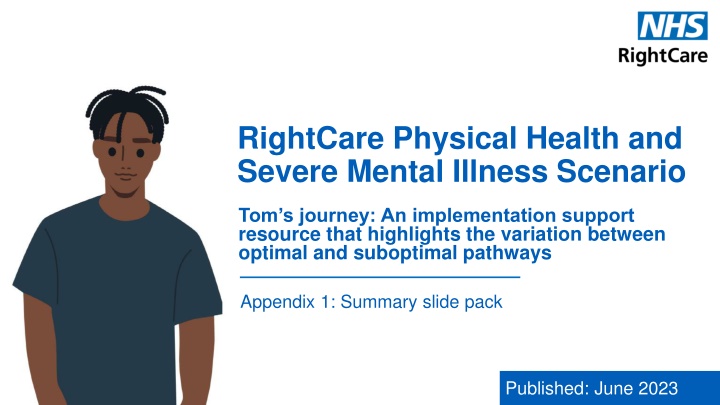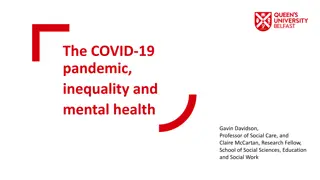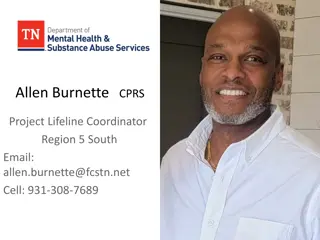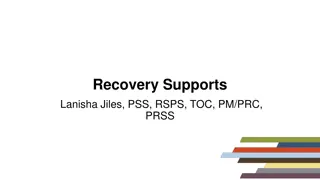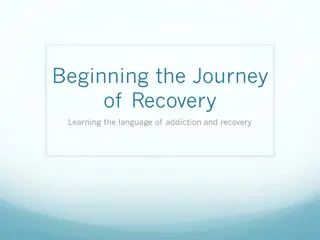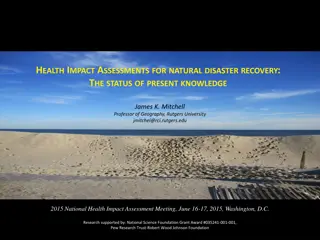Tom's Mental Health Journey: A Path to Recovery
Tom, a 22-year-old struggling with severe mental illness, shares his challenging experiences navigating a suboptimal healthcare pathway. Follow his story to understand the barriers and opportunities for improving mental health care delivery and outcomes.
Download Presentation

Please find below an Image/Link to download the presentation.
The content on the website is provided AS IS for your information and personal use only. It may not be sold, licensed, or shared on other websites without obtaining consent from the author.If you encounter any issues during the download, it is possible that the publisher has removed the file from their server.
You are allowed to download the files provided on this website for personal or commercial use, subject to the condition that they are used lawfully. All files are the property of their respective owners.
The content on the website is provided AS IS for your information and personal use only. It may not be sold, licensed, or shared on other websites without obtaining consent from the author.
E N D
Presentation Transcript
RightCare Physical Health and Severe Mental Illness Scenario Tom s journey: An implementation support resource that highlights the variation between optimal and suboptimal pathways Appendix 1: Summary slide pack Published: June 2023
Toms story: This is the story of Tom s experience of physical healthcare and severe mental illness care pathway, and how it could be so much better. Throughout the pathways we have highlighted the key improvement themes that are important in delivering an optimal pathway. In this scenario we examine a physical health and severe mental illness pathway, comparing a suboptimal but realistic scenario against an optimal pathway. 1 2 4 3 This document is intended to help commissioners and providers to understand the implications, both in terms of quality of life and cost, of shifting the care pathway. It shows how the RightCare methodology can help clinicians and commissioners to improve the value and outcomes of the care pathway.
Introducing Tom Tom is 22 and lives on his own in a student flat in a small city. He is black and grew up in a small town, with a supportive family, a good circle of friends and played football for a local club three times a week. He was described by his teachers as a bright and capable young man. He achieved good grades and got a place at university to study mathematics before pursuing his ambition of becoming a teacher. Tom smoked cigarettes and regularly drank alcohol socially with friends. Towards the end of his first year at university he experimented with recreational drugs and began to regularly smoke cannabis. When Tom was 20, he began to experience feelings of being on edge and started experiencing intrusive and unwanted thoughts which became more critical and intense. By the time he was 22, Tom was isolated and frightened. His mum became increasingly concerned and helped Tom to contact his GP.
Tom and the suboptimal pathway January Year 1: GP refers Tom to mental health outpatients Tom s GP referred him for a routine mental health outpatient appointment. The appointment was ineffective as there was no detailed discussion about Tom s actual diagnosis, it was also not recorded on his primary care record. He was prescribed an atypical antipsychotic but no further information was given in terms of benefits or side effects. Tom stopped taking the medication after struggling to cope with the side effects. As his mental health deteriorated, he was referred to the crisis team by his GP. Tom continued to drink heavily and smoke cannabis to cope with his symptoms. He wasn t asked at any point if he wanted to reduce his alcohol, smoking or cannabis use. March Year 1: Tom struggles to attend appointments and his physical health deteriorates Tom returned to live with his parents, who were not provided with any information about his illness or carers support. After a year of being under the care of the crisis team, he was discharged back to his GP. A discharge letter was sent asking the GP to monitor his condition, but it did not include any baseline measurements. Tom became more anxious and isolated. He did not attend his annual health check with his GP. Tom didn t see anyone professionally on discharge and received support only from his parents. He continued to drink and smoke heavily and was taking his antipsychotic medication erratically. Combined with his inactivity, he consequently gained a considerable amount of weight. March Year 3: Tom is isolated, drinking heavily, pre-diabetic and needs regular crisis care At 25, Tom was single and isolated. He struggled with his symptoms, was inactive, drank and smoked heavily. Tom did not attend any of the GP s physical health checks and his non- attendance was not followed up. Tom had several spells of needing crisis mental health team support. The crisis team reviewed his physical health, but these checks were never reported to his GP or recorded on his primary health care record. Tom developed high blood pressure, gained further weight and his blood lipid result suggested hyperlipidaemia. He was referred to cardiology but was discharged after not attending his appointment. Tom s parents struggled to receive consistent support as they were not registered carers. Tom was taken to hospital after experiencing breathlessness and chest pain. He was admitted to the emergency assessment unit and was found to have dangerously elevated cholesterol levels and prediabetes. He was at very high risk of having a heart attack and had an abnormal liver function test. He was referred to a liver specialist and endocrinologist. January Year 8: Tom develops diabetes, cardiovascular disease, and his mental health is very poor At 29, Tom was diagnosed with type 2 diabetes and was prescribed daily metformin. Reducing his heart disease risk was a priority. He was under the long-term care of the cardiology team but often missed these appointments. His mum tried to manage his appointments and always had to seek support from his mental health team to take him. Tom s GP requested that his physical health was reviewed and monitored by the mental health team due to Tom s frequent non-attendance. Tom and his family felt completely overwhelmed by the challenges of managing both his physical and mental illness, compounded by their uncertainty about who to go to for help. Tom s health deteriorated to such a degree that it was unlikely he would be able to reverse his diabetes or heart disease through lifestyle changes, which would almost certainly result in Tom dying prematurely.
Tom and the optimal pathway January Year 1: GP refers Tom to EIP service Tom s GP received an urgent referral for him to a community-based early intervention in psychosis (EIP) service. Following assessment, Tom was diagnosed with a First Episode Psychosis. He was given the opportunity to discuss medications and side effects with the specialist mental health pharmacist, who was part of his MDT, and was prescribed an antipsychotic. Tom s physical health was assessed and he received information about available support including personal health budgets, referral to an alcohol nurse specialist, and a stop smoking support service specialising in people with severe mental illness. He was referred to his university s Disability Advisory and Support Service for advice and support. March Year 1: Co-ordinated care and the power of peer support Tom returned to live with his parents, who were included in his care planning and were offered carers support. Tom received an information pack about the support he could expect to receive. Tom s GP practice took over the long term prescribing of antipsychotic medication and provided evidence for Tom s university to support a course break. Tom built up a trusting relationship with his care coordinator and together they devised a personalised care and support plan. He was referred to a third sector organisation that supported individuals with mental health problems to re-engage and build confidence. He began to feel less isolated. Tom s EIP team and GP worked together to ensure that information on physical health checks was shared, recorded on the electronic primary care record, and that there was clarity on lead responsibility for the checks. After three years with the EIP team Tom was discharged back to his GP. As part of this transition, Tom s care coordinator organised a handover meeting with Tom s GP and the primary care mental health specialist support worker. March Year 3: Regular assessments keep health problems in check before they escalate Tom continued to have an annual physical health check with his GP and was supported to attend by his specialist support worker. As Tom had experienced weight gain as a medication side effect, he was referred to a community dietician and attended sports activities through the third sector programme. At 25, Tom was free of psychotic symptoms. He continued to take his antipsychotic medicine and felt fully informed and involved in decisions about his care. He had ongoing engagement with the EIP team. He found the peer support invaluable and felt less isolated. At Tom s last health check, it was noted that his cholesterol was raised, the GP proactively managed this though a medication plan and regular review. January Year 8: Flexible, sensitive personalised care and support planning helps Tom s mental and physical health stabilise Tom continued to lose weight, was more active and volunteered in the sports group programme as a peer support worker. He successfully stopped smoking with the support of the smoking cessation team. Every year, Tom received a text message from his GP practice inviting him for a physical health check. At 29, Tom s mental health had stabilised. He continued to need antipsychotic medication and saw his GP for medication reviews on an annual basis. There had been no need to refer him to any specialist as his care plan and support from the primary care team kept him well. Tom had one personalised care and support plan that was visible to all his primary care workers, and his parents, that was reviewed as part of his annual review. He actively managed his physical health, enrolled on a college course, and grew in self-belief and confidence.
Key themes of optimal care Tailored outreach Personalised care and support planning (PCSP) Collaboration and alliance Don t just screen, intervene - The Lester Tool The Lester (2014) tool (also known as the Lester Cardio-metabolic Health Resource) helps clinicians to assess the cardiovascular health of patients with SMI and recommends the best course of intervention. People with SMI have higher than average non-attendance for appointments. Some of these can be avoided by addressing the individual barriers and making reasonable adjustments. PCSP is essential to ensure people with SMI are supported and live their lives in a way that matters to them. It should address the full needs of the service user, taking steps to combat loneliness, isolation and promoting wider engagement in self-care, exercise, healthy eating and lifestyle. The NHS Long Term Plan identifies the need to join up services across primary, secondary, voluntary and social care in order to promote equal access, early intervention, choice, and recovery based on NICE quality standards of access for people with mental health problems. It brings together advice from a number of NICE guidelines and is also designed to take into account the impact of antipsychotic medication on an increased risk of cardiovascular disease in people with SMI. It is important for these factors to be considered, and for reasonable adjustments to be made, when designing service models to deliver health checks and follow-up interventions. Better partnership across services and systems can help share expertise, instil confidence and overcome barriers to high quality care. Social prescribing supports PCSP by involving shared decision making. Good communication helps to avoid duplication or fragmentation of care.
Key themes of optimal care Review, monitoring and sharing physical health information Regular assessment and care planning Ensuring a personal health budget is explained and used System awareness and training It is important that clinical lead responsibility for physical health is clear between service providers. Adults with psychosis or schizophrenia should have a regular health check for problems such as weight gain, diabetes, and heart, lung and breathing problems. The results should be shared between their GP surgery and mental health team. There should also be shared decision-making to ensure informed choice. The Long Term Plan made a clear commitment to expand personalised care and personal health budgets. All healthcare staff should feel competent and confident to support people with SMI to better manage their physical health. Where physical health checks or interventions are delivered in one setting, there needs to be a mechanism in place to ensure that clinicians in other settings have access to the latest information. If data is not shared effectively, people with SMI can be subject to repeat checks. People who are eligible for section 117 aftercare under the Mental Health Act have a legal right to a personal health budget. Annual training for staff to support those with mental illness would also improve their physical healthcare. How to improve the physical health of people with SMI: A training film. Improving physical healthcare for people living with SMI in primary care: Guidance for CCGs. Psychosis and schizophrenia in adults (NICE) Quality Standard QS80 statement 6: Adults with psychosis or schizophrenia should have specific comprehensive physical health assessments. Practice-level SMI register dashboards are essential in ensuring that patients due any of the checks are pro-actively contacted in a timely manner.
Areas for systems to consider Below are some of the questions featured in the scenario. They are to support discussion and investigation within local systems and are focused on the key optimal themes that can lead to improvement in physical healthcare for people with severe mental illness: Is there a clear shared care protocol in place outlining roles and responsibilities across primary and secondary care services for optimal physical health care of people with SMI, including information sharing requirements to enable alignment of the SMI register between primary and secondary care? 1 Don t just screen, intervene: Is the Lester Tool (a summary poster to guide health workers to assess the cardiometabolic health of people experiencing psychosis and schizophrenia) routinely throughout your system and are staff trained to use it? Is there a comprehensive workforce development plan being implemented that will ensure staff feel confident and competent to work with people with SMI and provide optimal physical health care and avoid diagnostic overshadowing ? Are a range of methods used to effectively communicate and engage people with SMI about assessments and follow up e.g. peer support approaches, tailored invitation letters, tailored text messages and phone calls, opportunistic delivery of health checks during other contacts e.g. for repeat prescriptions, multiple contacts and communications between appointments, or home visits where indicated? Are you using shared decision-making to ensure monitoring of medication and side effects is taking place? 2 3 4 5 Is support available for people with SMI to help them access and take up public health or locally commissioned community behaviour change services - for example via peer support workers or care navigators? 6
Further information For more information about Tom s journey or RightCare: rightcare@nhs.net www.england.nhs.uk/rightcare www.future.nhs.uk/NationalRightCare @NHSRightCare Click here for the full scenario
